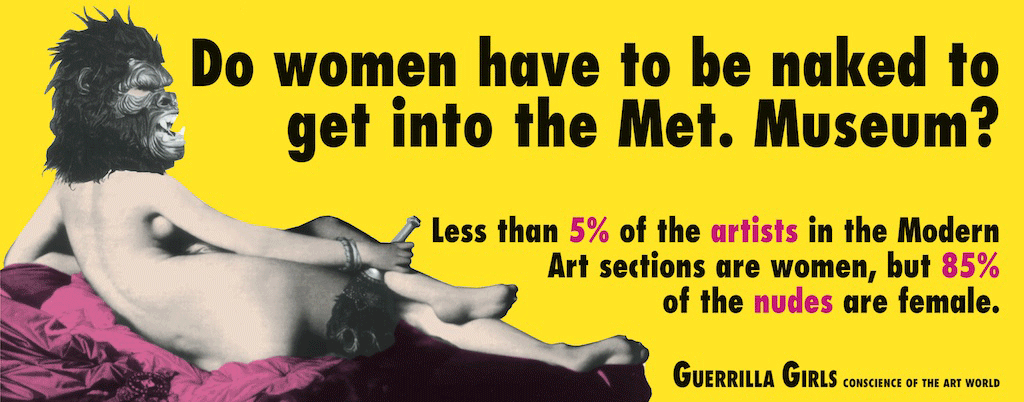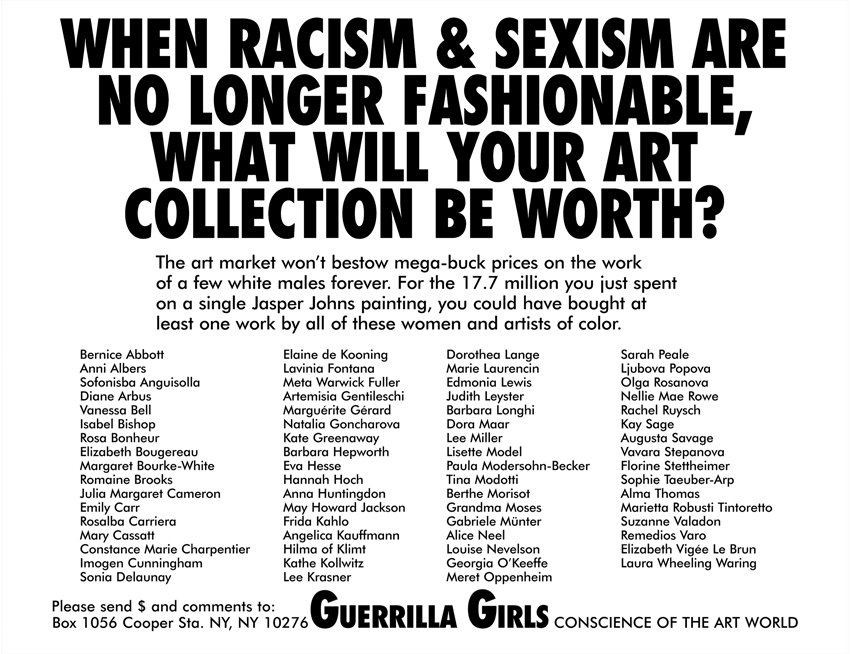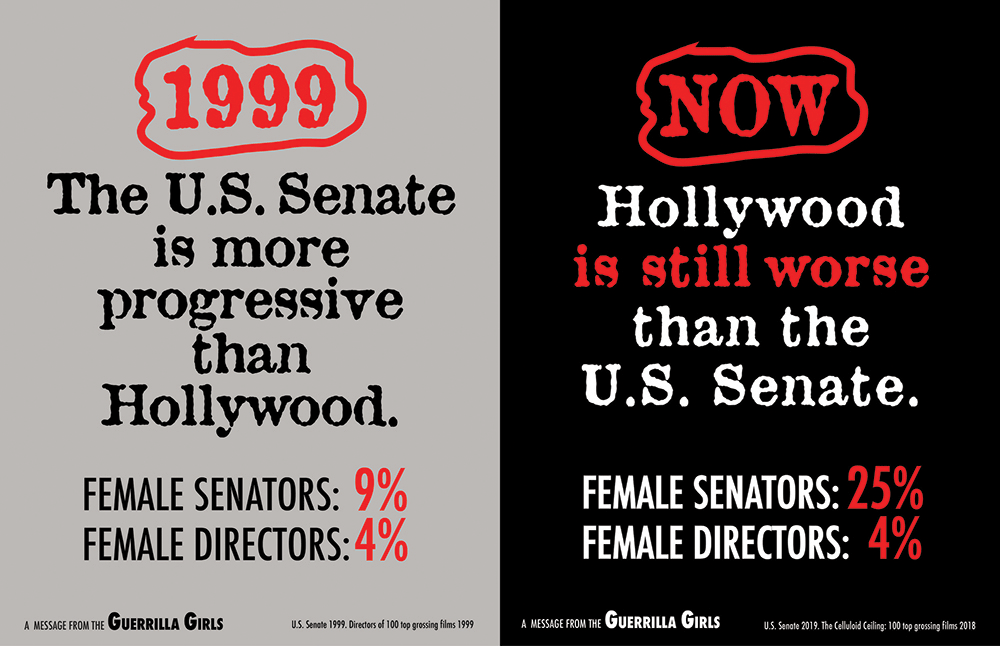The Guerrilla Girls are a group of feminists committed to battling gender and racial inequality. Unlike other groups, they criticize the corrupt and discriminatory culture within the art community in a humorous and creative manner.
From books to banners, the team provoke subversive reactions through their chosen form of protest: guerrilla communication. By adopting blunt statistics and bad-mannered imagery, the Guerrilla Girls uncover the hypocrisy and negligence that has been institutionalized in the art sphere.
To conceal their identities, they execute under the guise of gorilla masks. As a tribute, the group picked deceased female artists as pseudonyms, such as Frida Kahlo, Käthe Kollwitz and Alice Nee.
In 1985, their mission began to form. They believe in "an intersectional feminism that fights for human rights for all people." By calling out the unjust aspects of film, politics, art and mainstream culture the Guerrilla Girls distinguish the ostracized in their works, paving the way for the United Nations Sustainable Development Goals for Gender Equality and Reduced Inequalities in the art world.
The group formed in response to the Museum of Modern Art’s 1984 exhibition, An International Survey of Recent Painting and Sculpture. The exhibition asserted that the most important painters and sculptors' works were displayed.
According to their press release, of the 165 artists shown only 13 of them were women. The number of artists of colour that were included in the exhibition was even smaller, none of which were women.
“Any artist who wasn’t in the show should rethink his career,” said show curator Kynaston McShine in an interview from the book, Confessions of the Guerrilla Girls. This underlined the implicit gender bias that elicited what later formed the Guerrilla Girls as a response.
At the height of the contemporary art movement, the Guerrilla Girls recognized the lack of representation of female artists and curators in renowned galleries. Museums predominantly featured works by white male artists, reinforcing the disparity in power.
In addition, the Guerrilla Girls drew particular attention to the abundance of art portraying the nude female form. In 1989, they ran an advertisement on New York City buses that divulged the true nature of the Metropolitan Museum of Art titled, "Do women have to be naked to get into the Met. Museum ?"

This project continued over the years, holding recounts in 2005 and 2012. According to the Guerrilla Girls, between 1989 to 2005 the percentage of female artists in the Modern Art sections decreased to three per cent. However, the number of nudes that were female reduced minutely from 85 per cent in 1989 to 83 per cent in 2005. In 2012, the percentage of female artists went up to four per cent and the number of nudes that were female decreased to 76 per cent.
Since then, the project has appeared elsewhere in the form of books, in dormitory rooms, streets and ironically in museums themselves or, as the Guerrilla Girls put it, "blasting them on their own walls for their bad behaviour and discriminatory practices."
The Guerrilla Girls broadened their agenda to include tackling racial discrimination in the art world and internationally. In 1987, they made an exhibition disclosing the Whitney Biennial Museum of Modern Art’s disgraceful lack of exhibiting artists of colour and women.
By 1990, they issued a poster on tokenism during Black History Month and Women’s History Month. By only celebrating women and artists of colour during these months, the Guerrilla Girls highlight the hypocrisy of art shows perfunctory efforts to appear inclusive.
Using their wit and irony to their advantage, they started making direct interventions. In 1992 they organized demonstrations at the opening of the Guggenheim Museum SoHo for only showing white male artists which they handed out postcards and gorilla masks for protestors to use.
In the 1980s, they exposed the bewildering monetary choices made at auctions. Now targeting a more complex issue, the Guerrilla Girls ask collectors a crucial question: What is more economically worthwhile – collecting epoch-making pieces or merely spending money documenting the historical power of white male artists?
The poster itself expresses how with US$17.7 million collectors could either buy one singular painting by Jasper Johns or could purchase at least one work from 67 influential female artists (including artists such as Mary Cassatt and Frida Kahlo). Their confrontational title for the piece underlines how in time these investments will turn sour: When Racism & Sexism are No Longer Fashionable, What Will Your Art Collection Be worth?

Their posters still withstand today as these issues have not yet been amended. According to Artnet, work produced by women artists accounted for only US $4 billion of the $196.6 billion that was spent on actions from 2008 to 2019. Thus, only two per cent of total sales were women, highlighting the gender gap’s prevalence in more current auctions.
On top of this, in November 2021 ArtTactic reported that women account for a scarce 16 per cent of the NFT art market and only five per cent of income generated from NFTs goes to female artists.
In another poster, the Guerrilla Girls highlight how economic inequality is even poorer for women artists than the average gender pay gap in America in 1985. Earning only one-third of what their male counterparts earned, women artists were and are not only marginalized but also exploited.
The largest culprit of the gender wage gap is severe under-representation. Mary Ann Sieghart, the host of BBC’s Recalculating Art, expresses the inadequacy of textbooks using the world-renowned bestselling book EH Gombrich’s The Story of Art mentions of only one female artist in its 688 pages as an example.
The Guerrilla Girls continue to update their "weenie counts" to include issues within and outside of the scope of art. This poster made in 2019, ironically depict the unprogressive aspects of both the film industry and the government.

In more recent years, the group touches on topics such as abortion rights, the male gaze, global warming, politics, Black American incarceration, sexual assault and the list goes on.
To date, the Guerrilla Girls have written three books, produced nearly 100 posters, and created multitudes of printed projects, informative videos, lectures and presentations.
Unparalleled in their empowering observations and humorous critiques, the Guerrilla Girls persuasively spark international dialogue on the importance of representation while simultaneously reprimanding gender and racial inequalities with the arts and beyond.
To find out more about the Guerrilla Girls protests and pursuits, visit their website.
